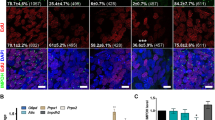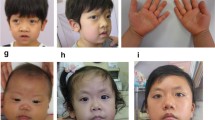Abstract
During a large-scale screen of a human fetal brain cDNA library, a novel human gene GNB2L1 encoding a novel RACK (receptor of activated protein kinase C) protein was isolated and sequenced. The cDNA is 1142 bp long and has a predicted open reading frame encoding 316 aa. The predicted protein shows higher similarity to rat RACK1 and many RACK proteins of different organisms including Drosophila, C. elegans, mouse, rat, human, C. fasciculata, zebrafish, A. thaliana, S. cerevisiae and so on, suggesting it is conserved during evolution. The gene was mapped to human chromosome 5q35.3, the telomer position of chromosome 5q, in which the disease gene for early-onset primary congenital lymphedema was mapped. Also, 5q35.3 is a frequently reported location for cytogenetic and molecular abnormalities in renal cell carcinomas. The gene has 8 exons and 7 introns. It is expressed ubiquitously in many human tissues detected by northern blot analysis and RT-PCR.
Similar content being viewed by others
References
Rybczynska M, Ksiazek K, Kaczmarek J, Zaklad, CK, Katedra, BF, Akademia Medycznaim. K & Marcinkowskiegow Poznaniu (2000) Postepy Hig Med Dosw. 54(6): 777–796
Rotenberg SA & Weinstein LB (1991) Biochem. Molec. Aspects Selected Cancers. 1: 25–73
Newton AC (1995) J. Biol. Chem. 270: 28495–28498
Wang HY & Friedman E (2001) Biol. Psychiatry. 50: 364–370
Friedman E & Wang HY (1989) J neurochem. 52: 187–192
Wang HY & Friedman E (1990) Mol. Pharmacol. 37: 95–79
Wang HY & Friedman E (1996) Biol. Psychiatry. 37: 75–79
Mochly-Rosen D, Henrich CJ, Cheever L, Khaner H. & Simpson, PC (1990) Cell. Regul. 1: 693–706
Lambright DG, J Sondek A Boham, Skiba N.P, Hamm HE & Sigler PB (1996) Nature 379: 311
Chang BY, Conroy KB, Machleder EM & Cartwright CA (1998) Mol. Cell. Biol. 18: 3245
Liliental J & Chang DD (1998) J. Biol. Chem. 273: 2379–2383
Yarwood S, Steele MR, Scotland G, Houslay MD & Golger GB (1999) J. Biol. Chem. 274: 14909–14917
Croze E, Usacheva A, Asarnow D, Minshall RD, Perez HD & Colamonici O (2000) J. Immunol. 165: 5127–5132
Reinhardt J & Wolff T (2000) Vet Microbiol. 74(1-2): 87–100
Mochly-Rosen D, Khaner H & Lopez J (1991). Proc. Natl. Acad. USA. 88: 3997–4000
Csukai M, Chen CH, De-Matteis MA & Mochly Rosen (1997) J. Biol. Chem. 272: 29200–29206
Taladriz S, Gonzalez-Aseguinolaza G, Marquet A & Larraga V (1999) FEBS Lett. 443(3): 375–380
Hamilton LC & Wright JM (1999) Mar. Biotechnol. 3: 279–285
Ron D, Chen CH, Caldwell J, Jamieson L, Orr E & Mochly-Rosen D (1994) Proc. Natl. Acad. Sci. USA 91: 839–843
Imai Y, Suzuki Y, Tohyama M, Wanaka A & Takagi T (1994) Brain Res. Mol. Brain Res. 24 (1-4): 313–319
Kwon HJ, Bae S, Son YH & Chung HM (2001) Genes Evol. 211(4): 195–197
Vani K, Yang G & Mohler J (1997) Biochim. Biophys. Acta 1358(1): 67–71
Lardans V, Serra E, Capron, A & Dissous C (1998) Exp. Parasitol. 88(3): 194–199
Won M, Park SK, Hoe K.L, Jang YJ, Chung KS, Kim DU, Kim HB & Yoo HS (2001) Biochem. Biophys. Res. Commun. 282(1): 10–15
Vahlkamp L & Palme K (1997) Plant Physiol. 115 (2): 863
Fossey SC, Kuroda S, Price JA, Pendleton JK, Freedman BI & Bowden DW (2000) Mamm. Genome. 11 (10): 919–925
Neer EJ, Schmidt CJ, Nambudripad R & Smith TF (1994) Nature 371: 297
Newton AC (1997) Curr. Opin. Cell Biol. 8: 168–173
Jung J, Zheng M, Goldfarb, M & Zaret KS (1999) Science 284: 1998–2003
Kaipainen A, Korhonen J, Mustonen T, Van-Hinsbergh VWM, Fang GH, Dumont D, Breitman M & Alitalo K (1995) Proc. Nat. Acad. Sci. 92: 3566–3570
Fofanova O, Takamura N, Kinoshita E, Parks JS, Brown MR, Peterkova VA, Evgrafov OV, Goncharov NP, Bulatov AA, Dedov II & Yamashita S (1998) J. Clin. Endocr. Metab. 83: 2601–2604
Traver S, Bidot C, Spassky N, Baltauss T, De-Tand M.-F, Thomas J.-L, Zalc B, Janoueix-Lerosey I. & De Gunzburg J (2000) Biochem. J. 350: 19–29
Evans AL, Brice G, Sotirova V, Mortimer P, Beninson J, Burnand K, Rosbotham J, Child A & Sarfarazi M (1999) Am. J. Hum. Genet. 64: 547–555
Ferrell RE, Levinson KL, Esman JH, Kimak MA, Lawrence EC, Barmada MM & Finegold DN (1998) Hum. Molec. Genet. 7: 2073–2078
Omori Y, Kyushiki H, Takeda S, Suzuki M, Kawai A, Fujiwara T, Takahashi E & Nakamura Y (1997) Cytogenet. Cell Genet. 78: 285–288
Saito A, Fujii G, Sato Y, Gotoh M, Sakamoto M, Toda G & Hirohashi S (2002) Mol. Pathol. Feb. 55(1): 34–39
He DY, Vagts AJ, Yaka R & Ron D (2002) Mol. Pharmacol. Aug. 62(2): 272–280
Author information
Authors and Affiliations
Rights and permissions
About this article
Cite this article
Wang, S., Chen, Jz., Zhang, Z. et al. Cloning, expression and genomic structure of a novel human GNB2L1 gene, which encodes a receptor of activated protein kinase C (RACK)* . Mol Biol Rep 30, 53–60 (2003). https://doi.org/10.1023/A:1022212731316
Issue Date:
DOI: https://doi.org/10.1023/A:1022212731316




